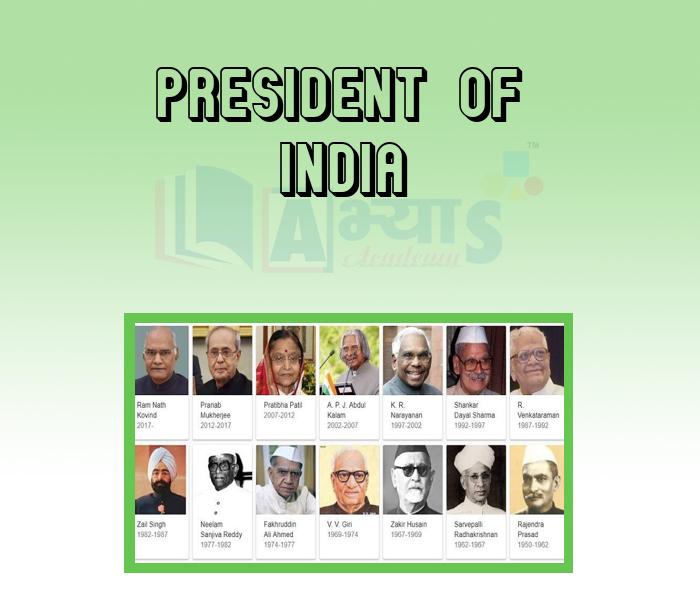President of India












President of India
The President of India is the head of state and first citizen of India, as well as the Supreme Commander of the Indian Armed Forces. Despite Article 53 of the Constitution stating the President can exercise powers directly, with few exceptions, all of the authority vested in the President is in practice exercised by the Council of Ministers, headed by the Prime Minister.
Constitutional role of the Indian Constitution states, "There shall be a President of India". Article 53(1) vests in the President the executive powers of the Union, which are exercised either directly or through subordinate officers in accordance with the Constitution. Although the Constitution explicitly says that the president is the executive head of the state, real executive power is exercised by the Council of Ministers, headed by the Prime Minister. This is inferred from Article 74 of the Indian Constitution, providing for a council of ministers to aid and advise the President who shall, in exercise of his functions, act in accordance with such advice.
However, the Article 74(e) bars all courts completely from assuming even an existence of such an advice Therefore, from the courts' point of view, the real executive power lies with the President. As far resident's decision and action are concerned, no one can challenge such decision or action on the that it is not in accordance with the advice tendered by the Ministers or that it is based on no advice.
The president of India shall, before entering upon his office, make and subscribe in the presence of Chief Justice of India or, in his absence, the senior-most Judge of the Supreme Court available, an oath affirmation that he/she shall protect, preserve and defend the Constitution (Article 60).
Which of the following is also known as the Supreme Commander of the Indian Armed Forces ? | |||
| Right Option : A | |||
| View Explanation | |||
Which of the following are correct : (a) The President is also known as the Supreme Commander of the Indian Armed Forces. (b) The Prime Minister of India is the head of state and first citizen of India. (c) Constitutional role of the Indian Constitution states, "There shall be a President of India". | |||
| Right Option : C | |||
| View Explanation | |||
_________________________ vests in the President the executive powers of the Union, which are exercised either directly or through subordinate officers in accordance with the Constitution. | |||
| Right Option : B | |||
| View Explanation | |||
Students / Parents Reviews [10]
I have spent a wonderful time in Abhyas academy. It has made my reasoning more apt, English more stronger and Maths an interesting subject for me. It has given me a habbit of self studying

Yatharthi Sharma
10thMy experience with Abhyas academy is very good. I did not think that my every subject coming here will be so strong. The main thing is that the online tests had made me learn here more things.

Hiya Gupta
8thIt was a good experience with Abhyas Academy. I even faced problems in starting but slowly and steadily overcomed. Especially reasoning classes helped me a lot.

Cheshta
10thAbhyas is a complete education Institute. Here extreme care is taken by teacher with the help of regular exam. Extra classes also conducted by the institute, if the student is weak.

Om Umang
10thMy experience was very good with Abhyas academy. I am studying here from 6th class and I am satisfied by its results in my life. I improved a lot here ahead of school syllabus.

Ayan Ghosh
8thMy experience with Abhyas is very good. I have learnt many things here like vedic maths and reasoning also. Teachers here first take our doubts and then there are assignments to verify our weak points.

Shivam Rana
7thA marvelous experience with Abhyas. I am glad to share that my ward has achieved more than enough at the Ambala ABHYAS centre. Years have passed on and more and more he has gained. May the centre flourish and develop day by day by the grace of God.

Archit Segal
7thAbhyas Methodology is very good. It is based on according to student and each child manages accordingly to its properly. Methodology has improved the abilities of students to shine them in future.

Manish Kumar
10thBeing a parent, I saw my daughter improvement in her studies by seeing a good result in all day to day compititive exam TMO, NSO, IEO etc and as well as studies. I have got a fruitful result from my daughter.

Prisha Gupta
8thAbout Abhyas metholodology the teachers are very nice and hardworking toward students.The Centre Head Mrs Anu Sethi is also a brilliant teacher.Abhyas has taught me how to overcome problems and has always taken my doubts and suppoeted me.
